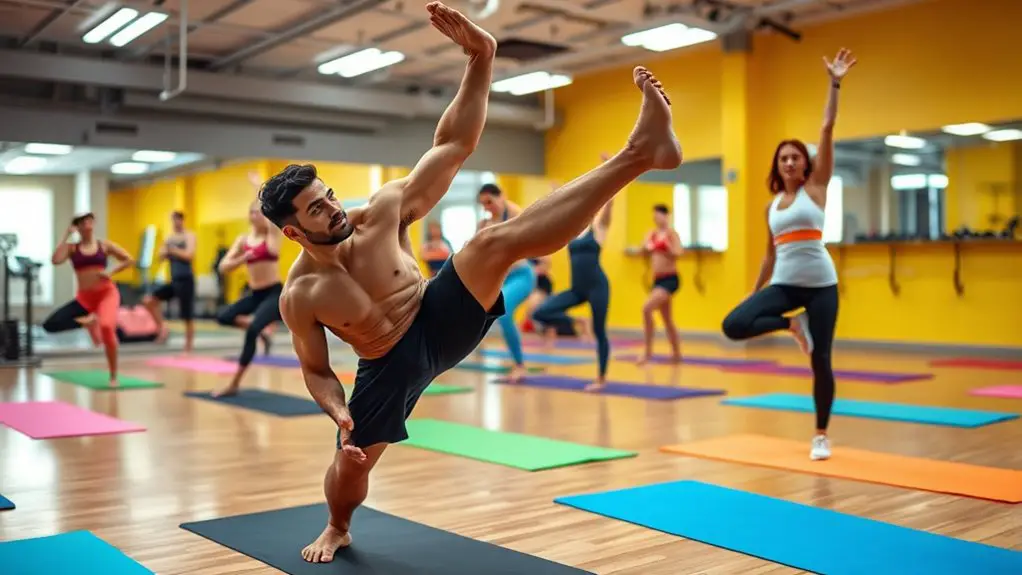Dynamic stretching reduces injury risk by actively preparing your muscles and joints for movement. It increases your range of motion, improves blood flow, and enhances neuromuscular control, making your body more responsive to activity. By mimicking specific movements, it conditions your body for the demands of exercise, decreasing the likelihood of strains and sprains. Incorporating these stretches into your warm-up routine helps guarantee you're ready to perform. There's so much more to discover about the benefits it offers.
Understanding Dynamic Stretching and Its Benefits
Dynamic stretching is a powerful tool for enhancing your workout routine and reducing injury risk. Unlike static stretches, which hold positions, dynamic stretches involve moving parts of your body through a range of motion. This not only warms up your muscles but also prepares your joints for the freedom of movement they'll experience during your workout.
Incorporating dynamic stretches into your routine can improve your flexibility, strength, and coordination, allowing you to feel more liberated in your movements. Think of exercises like leg swings, arm circles, or walking lunges. These stimulate blood flow, increase heart rate, and enhance your overall performance. Additionally, strength training is crucial for maintaining control during rapid movements, further reducing the risk of injury.
The Science of Muscle Activation
Understanding how muscle activation works is essential for preventing injuries during physical activity. When you engage in dynamic stretching, you stimulate your muscles in specific ways, enhancing their readiness for movement. Additionally, incorporating mobility training into your routine can further improve your muscle efficiency and reduce the risk of injury. Let's explore the mechanisms behind this activation and its impact on keeping you safe while you exercise.
Importance of Muscle Activation
While many athletes focus on flexibility and strength, muscle activation plays an essential role in preparing your body for physical activity. It's not just about getting loose; it's about waking up your muscles and priming them for action. When you activate your muscles, you enhance their responsiveness, which can boost your performance and reduce the risk of injury. Think of it as tuning an instrument before a concert—your body needs to be in harmony. By incorporating dynamic stretching, you engage your muscles through movement, ensuring they're ready to support you. This activation helps improve coordination, balance, and overall body awareness, giving you the freedom to move with confidence and reducing the likelihood of strains or sprains during your activities.
Mechanisms of Stretching
When you stretch, your body undergoes several physiological changes that enhance muscle activation and prepare you for movement. Dynamic stretching increases blood flow to your muscles, raising their temperature and making them more pliable. This enhanced pliability allows for greater range of motion, letting you move freely and comfortably. Your nervous system also gets engaged, boosting the communication between your brain and muscles, which can lead to quicker reactions. Additionally, dynamic movements help stimulate the proprioceptors in your muscles and joints, making you more aware of your body's position and movement. By priming your muscles this way, you're not just getting ready for action; you're also tapping into your body's natural potential for agility and strength.
Effects on Injury Prevention
Dynamic stretching plays an essential role in injury prevention by enhancing muscle activation and coordination. By incorporating dynamic stretches into your routine, you can enjoy several benefits that contribute to a freer, more active lifestyle:
- Increases Range of Motion: It helps your muscles move better, reducing the likelihood of strains.
- Improves Blood Flow: Enhanced circulation warms up muscles, making them more pliable and ready for action.
- Enhances Neuromuscular Control: Better coordination can help you avoid awkward movements that lead to injuries.
- Prepares Your Body for Activity: Dynamic stretching mimics the movements you'll perform, easing your shift into physical exertion.
Enhancing Flexibility Through Movement
To enhance flexibility effectively, incorporating movement into your stretching routine is essential. Instead of holding static stretches, try dynamic movements that mimic the activities you love. Think of lunges with a twist or leg swings; these not only stretch your muscles but also engage them in a way that static stretches simply can't.
When you add movement, you're allowing your body to warm up gradually and adapt to a range of motions. This approach not only increases your flexibility but also prepares your muscles and joints for action. You'll feel more liberated in your movements and less restricted. Additionally, improved flexibility allows for smoother, more efficient movements that can elevate your overall athletic performance.
As you explore different dynamic stretches, listen to your body. Find what feels good and what enhances your natural flow. Remember, flexibility isn't just about reaching for your toes; it's about moving freely and confidently, enjoying every moment without limits. Embrace the freedom that comes from enhanced flexibility!
Improving Blood Flow and Circulation
Improving blood flow and circulation is essential for overall health and performance, especially as you engage in physical activities. Dynamic stretching is a fantastic way to get your blood pumping and enhance circulation. Here are a few benefits you can expect:
- Increased Oxygen Delivery: Better circulation means your muscles receive more oxygen, which boosts endurance.
- Enhanced Nutrient Supply: Improved blood flow helps deliver crucial nutrients to your muscles, promoting recovery and growth.
- Reduced Muscle Stiffness: Dynamic stretches loosen up your muscles, reducing the risk of injury and enhancing mobility.
- Elevated Heart Rate: Engaging in dynamic stretching raises your heart rate, preparing your body for the demands of your workout. Additionally, proper hydration before and during physical activities supports optimal blood flow and overall performance.
Preparing the Nervous System for Activity
As your blood flow increases from dynamic stretching, your nervous system also gears up for activity. This preparation is essential for achieving peak performance while minimizing injury risk. By engaging in dynamic stretching, you're not just loosening your muscles; you're sending signals to your brain that it's time to move. This connection enhances your reaction times and improves your coordination, allowing you to respond more effectively to your body's demands.
Your nervous system becomes more alert and ready, which means you can enjoy the freedom of movement without hesitation. Think of it as tuning in to your body's potential. You're activating your proprioceptors, which help your body understand its position and movement in space. This heightened awareness translates into greater control over your movements, making you feel more confident and liberated during your activities. Ultimately, preparing your nervous system sets the stage for an injury-free experience, empowering you to pursue your passions fully. Additionally, engaging your core muscles during dynamic stretches can further enhance core strength, which is vital for stabilizing your movements and preventing injuries.
Reducing Muscle Stiffness and Enhancing Performance
While many athletes focus on strength training and endurance, reducing muscle stiffness through dynamic stretching is equally important for peak performance. By incorporating dynamic stretches into your routine, you can access your body's full potential and move freely. Here are four key benefits you'll experience:
- Increased Range of Motion: Dynamic stretching helps loosen your muscles, allowing for greater flexibility.
- Enhanced Blood Flow: It increases circulation, delivering oxygen and nutrients to your muscles, which boosts performance.
- Improved Coordination: These movements activate your nervous system, leading to better body control and balance.
- Reduced Muscle Stiffness: Regular practice decreases tightness, making your muscles more responsive during activity.
Moreover, engaging in dynamic stretching as part of your warm-up routine can significantly enhance your athletic performance and reduce injury risk. Embracing dynamic stretching not only prepares you physically but also empowers you mentally, giving you the freedom to push your limits without the fear of injury. So, don't overlook this vital aspect of your training!
Incorporating Dynamic Stretching Into Your Routine
Incorporating dynamic stretching into your routine can transform your workouts and enhance your overall performance. Start by warming up with movements that mimic your workout, like leg swings or arm circles. This not only prepares your muscles but also increases your range of motion, giving you the freedom to move more fluidly.
Aim to include dynamic stretches before each session, whether you're hitting the gym, going for a run, or practicing yoga. It's about finding what feels right for you, so listen to your body and adjust as needed. You might also want to mix in some sport-specific stretches to target the muscles you'll be using the most. Additionally, dynamic stretching can help reduce the risk of sprains and strains, which are common injuries from improper technique.
Frequently Asked Questions
Can Dynamic Stretching Be Beneficial for Elderly Individuals?
Absolutely, dynamic stretching can be beneficial for elderly individuals. It helps improve flexibility, enhances mobility, and prepares your body for movement, allowing you to stay active and enjoy life without feeling restricted or vulnerable.
How Long Should a Dynamic Stretching Routine Last?
A good dynamic stretching routine should last about 10 to 15 minutes. This timeframe's enough to warm up your muscles and improve flexibility, helping you feel free and ready for your activities or workouts.
Is Dynamic Stretching Safe for Everyone?
Yes, dynamic stretching's generally safe for most people. However, if you've got specific injuries or conditions, it's best to consult a professional. Listen to your body, and adjust movements to suit your needs.
When Is the Best Time to Perform Dynamic Stretching?
When you're looking to elevate your performance, consider incorporating dynamic stretching during your warm-up. It's the perfect opportunity to prepare your body, enhancing flexibility and movement, ultimately setting you free for your workout or activity.
Can Dynamic Stretching Replace Static Stretching Entirely?
Dynamic stretching can't completely replace static stretching. Each has its benefits, and it's crucial to combine both for peak flexibility and performance. Embrace a balanced routine that suits your body's needs and movement goals.




